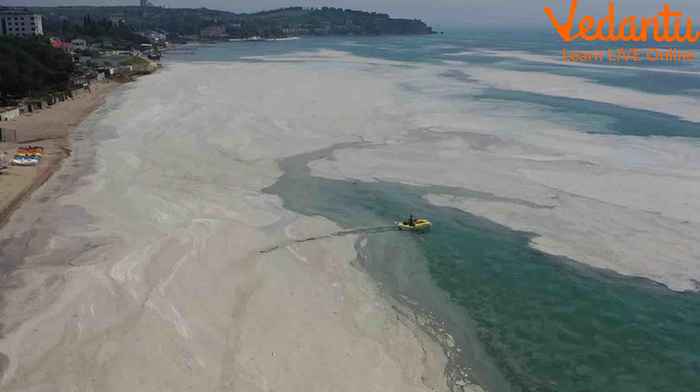Reason Behind The Formation of Sea Snot In Turkey
We, humans, are the only animals that are ruining their only home. We are the ones who deny the natural conditions and create a world of our own harming the world of other animals. One such problem, we have created is pollution. Whatever we produced gets dumped in the sea. From plastic to artificial chemicals, all get deposited in the marine ecosystem harming its balance.
This bane of modern civilisation recently surfaced in Turkey in the form of snot-like deposits. It is called sea snot by the researchers. It covered a huge area when compared to the area of the country. The appearance of this disgusting slime is an alarming development in the marine pollution we have been continuing for ages.
What is Sea Snot?
The accumulation of creamy, frothy, and slime-like substances at the top level of the seas and oceans is called sea snot. They appear like white squiggles on the water surface. They can also look like a dark oily patch floating on the surface. What it is made of?
When we get closer to a sea snot patch, we can clearly identify what it is made of. It is commonly termed sea saliva or sea mucilage. Its formation is not known but the source can be traced back to the chemicals and harmful materials dumped into the sea. It is sort of an amalgamation of inorganic and organic material quashed together to form something lighter than seawater.
This unpleasant and messy substance is quite sticky. When tested in the laboratories, it has been found that this slimy substance contains fragments of dead animals and plants, faeces, organic remnants of manmade pollution, etc. Some scientists consider it a gelatinous phase of marine snow.
When this snot rises up from the marine surface, it floats and creates a sticky covering on the water surface. It becomes very harmful to the marine ecosystem and even to humans. The sea snot phenomenon is common and can be seen in different parts of the world. Recently, it has been noticed in the Sea of Marmara, Turkey. The beautiful turquoise water has converted into a disgusting sludge.
A Brief Introduction to Marine Snow
Marine snow originates and surfaces in the oceans. It is made of phytoplankton and other microbes. As the other material begins to sink or submerge, the rest acts as a biological net that catches, faecal matter, decaying animals, dead animals, sediments, and other organic material flushing in the sea. As it resembles snowflakes to some extent, it is called marine snow.
Sea Snot in Turkey
How bad is the sea snot outbreak in Turkey? It is an aggravated situation of marine snow with a clear influence of pollution. In Turkey, the sea snot formed is quite thick and can be considered a mucilage disaster. Recep Tayyip Erdogan, the President of Turkey, has mentioned it as an alarm that all humans must be aware of.
The snot formed here turned uncontrollable. It has taken a massive shape with a depth of 30 metres from the water surface. Imagine how dangerous it can be for the marine ecosystem. You will be surprised to know that Turkey faces the same problem since 2007 but this year, it has made the news. The thick swathe of slime has invaded the ports and plagued the waterways.
It has been months since this slimy snot is being cleaned but of no use. You will be surprised to know the reason behind this big sea snot Turkey.

Sea Snot Formed in the Sea of Marmara in Turkey
Reason for Sea Snot Formation
As mentioned earlier, the sea snot formation has been disrupting life and the marine ecosystem since 2007 in Turkey. The year 2021 was the most devastating one. The sea snot took a whopping thickness of 30 metres and is growing.
The reason behind the massive growth of this sea snot is phytoplankton. Isn’t the growth of phytoplankton good for our marine ecosystem? It is good when it is controlled. Phytoplankton is the primary food source of the oceanic and sea biomes. When it grows abruptly forming a gel-like cover, it is extremely dangerous.
The Sea of Marmara connects the Aegean Sea and the Black Sea in the Mediterranean region. It has been found that untreated water running from the sewage deposited in the sea results in delivering nutrients that promote the growth of microalgae. You might have studied about algal bloom in the ponds and rivers happening due to eutrophication. Due to the same reason, the microorganisms grow much faster by consuming the nutrients released in the sea by untreated industrial wastewater.
They form a gelatinous chain of compounds called polysaccharides resulting in trapping other obnoxious materials floating on seawater. Hence, this snot covers the surface of the sea and cuts down sunlight and affects marine ecosystems.
Sea Snot bad for Marine Life
The Sea of Marmara is known for its fishing. The fishermen have been really affected by the formation of this massive sea snot. This marine mucilage is cutting down the sunlight entering the sea and hitting the floor.
It means that the microorganisms dwelling in the deeper regions will not be able to conduct photosynthesis. The food chain will experience a huge misbalance when the producers are unable to make food. This blanket of mucilage will also cut down oxygen and eventually, all the animals will die. Animals stuck in the sea snot will also suffer from mortal damage.
What Can We do?
Sewage treatment and wastewater plants are mandatory. We need to stop dumping waste in the sea. We have also learned that Mother Nature will return what we have done to her. This is high time we need to stop polluting our only planet at any cost.







